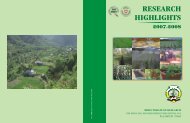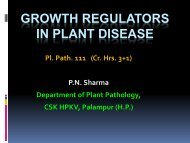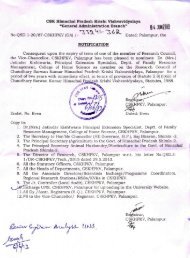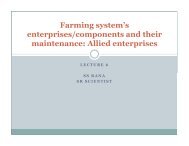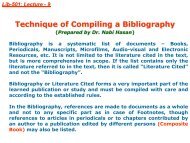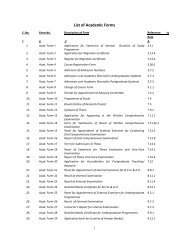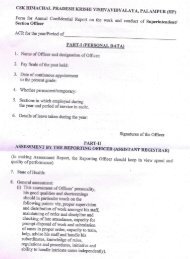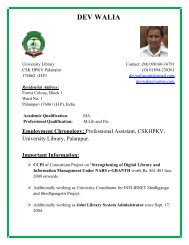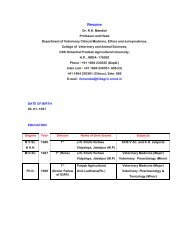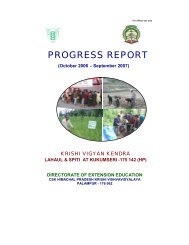info........ - CSK Himachal Pradesh Agricultural University
info........ - CSK Himachal Pradesh Agricultural University
info........ - CSK Himachal Pradesh Agricultural University
You also want an ePaper? Increase the reach of your titles
YUMPU automatically turns print PDFs into web optimized ePapers that Google loves.
13<br />
for most soil-crop situations. Dr. Suri has been engaged in the development of INM (use of<br />
chemical fertilizers + organics + biofertilizers) technology (with and without soil testing<br />
component) for rainfed cereals, pulses and oilseeds of <strong>Himachal</strong> <strong>Pradesh</strong>. He tried to<br />
conduct most of his research on cropping system basis which is actually the need of the day.<br />
Based on his original work, it was concluded that 50 per cent of recommended fertilizer<br />
nutrients could be saved through the use of organics and biofertilizers. He has developed<br />
fertilizer adjustment equations/models based on yield target concept for various crops which<br />
are usable by soil testing laboratories for making precise (as per soil tests, yield target<br />
chosen, etc.) and most judicious fertilizer recommendations to the cultivators. Dr. Suri’s<br />
above work facilitates recommendation of balanced doses of N, P and K (+organics and<br />
biofertilizers) for different levels of crop production (low, medium and high) ensuring<br />
maintenance of soil fertility at the same time. Since, the <strong>info</strong>rmation has been converted into<br />
very simple ready reckoners, these can be easily followed by the soil testing officers as well<br />
as the farmers.<br />
Actually, Dr. Suri reoriented the technical plan of work of Palampur Centre of the<br />
All India Co-orginated Research Project on Soil Test Crop Response (ICAR) by<br />
introducing the concepts of nutrient economy, healthy soils and high productivity<br />
by means of integrated nutrition. The outcome is the generation of data-base<br />
which is helpful in making fertilizer recommendations as elaborated above. Some<br />
of the findings of practical utility are given below:<br />
1. Fertilizer application based on yield target concept is superior to traditional<br />
approaches as reflected through higher yield, optimal economic returns and soil<br />
fertility build-up.<br />
2. Complementary use of FYM in rainfed maize, under yield target concept, resulted into<br />
fertilizer N, P and K economy of 40-60 per cent under various targets.<br />
3. Complementary use of biofertilizers in rainfed maize i.e. used phosphobacterial and<br />
Azotobacter cultures led to additional P and N savings of about 20 kg/ha each.<br />
4. Results from a long term experiment showed that NPK fertilizer doses for attaining<br />
targeted yields decreased with time due to fertility build-up.<br />
5. Blue green algae (BGA) application at 10 kg/ha in standing water in rice after 10 days<br />
of transplanting leads to fertilizer N saving of 30 kg N/ha. Moreover, it has a residual<br />
effect on following wheat (2 q/ha higher wheat grain).<br />
6. Farm yard manure (FYM) alone or along with nominal amounts of N say 40 kg N/ha<br />
cannot tap the production potential of rainfed maize-wheat system under low hill submontane<br />
conditions; P and K applications increase yields substantially.



